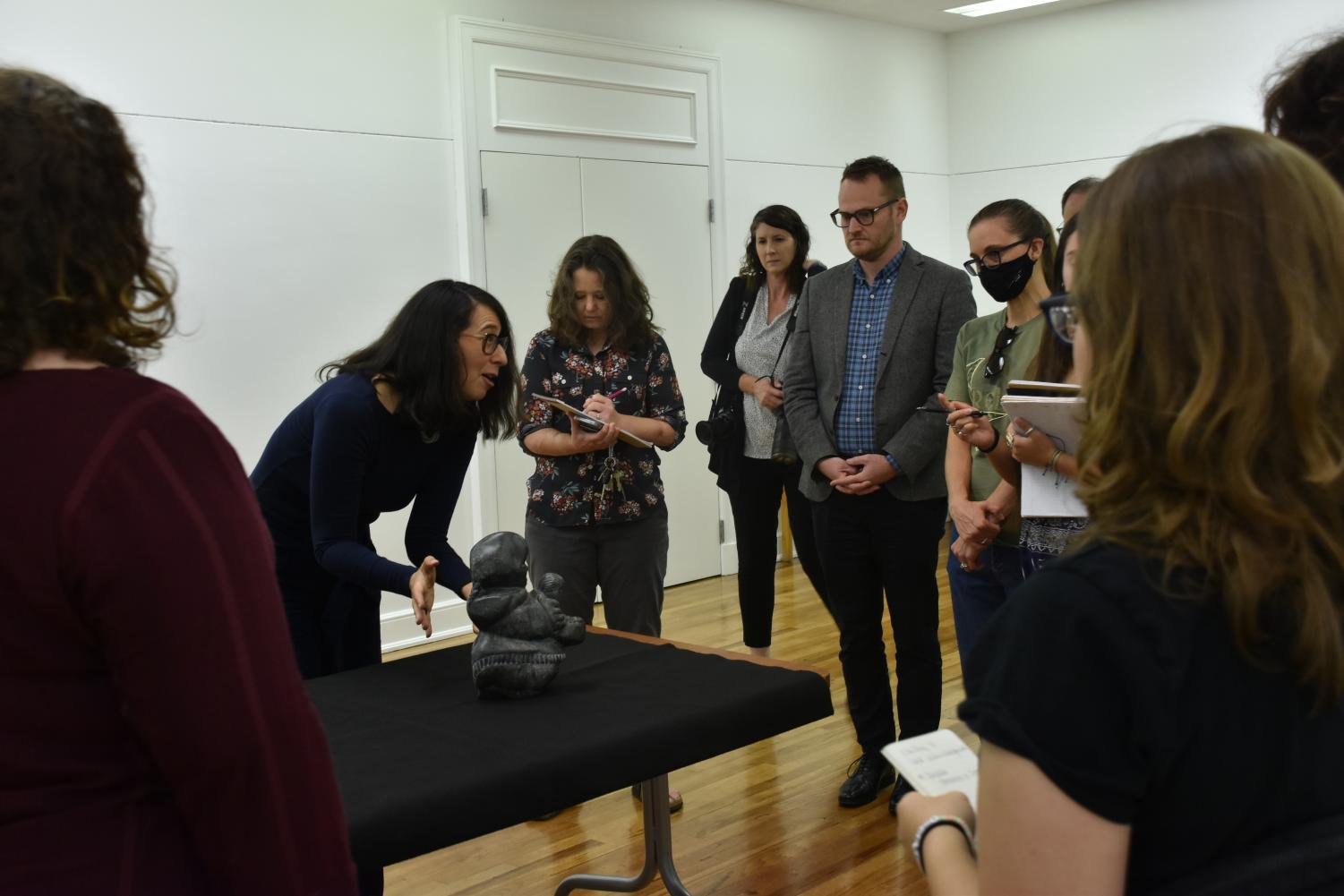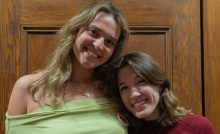Pitt launches Indigenous Cultural Festival with ‘Object Lesson: Inuit Sculpture’


Sylvia Rhor Samneigo, a senior lecturer in the History of Art and Architecture Department and UAG director and curator, leads the ‘Object Lesson: Inuit Sculpture’ event Tuesday evening.
The University Art Gallery’s Inuit sculpture depicts a mother and child. Both mother and child are bundled in warm clothing, with the mother wearing a decorated coat and hood, with two braid plaits at the back of her head. The mother carries the child in her arms.
The sculpture was presented at an object lesson event on Tuesday as a part of Pitt’s Office for Equity, Diversity, and Inclusion kick off for its first Indigenous Cultural Festival.The festival will take place from Sept. 19 to Sept. 25.
The object lesson showcased the work of Inuit sculptor Johnny Inukpuk’s soapstone carving, which was donated to the UAG by Donald Nevins in 2002. UAG hosted this event to discuss the history and issues surrounding Indeginous land ownership and the displaying of indigenous artwork in museum collections.
Sylvia Rhor Samneigo, a senior lecturer in the History of Art and Architecture Department and UAG director and curator, led the object lesson. The event also included a explanation of the process of making the sculpture by Paolo Piscitelli, a lecturer in the studio arts department.
The object lesson began with a general visual observation of the “lap-sized” sculpture, followed by Samaneigo asking for the audience’s first thoughts and descriptions of the work.
The soapstone is light gray-black, with brown and gray striations. Portions of the sculpture are smooth and patinated, such as the clothing and mother’s head, while others continue to show the original carvings and instrument markings, particularly along the decoration of the mother’s clothing.
Samaniego said this is a typical creation for Inukpuk, as he is famous for his depictions of mother and child, especially mothers withs distinctive heads.
Piscitelli then described the sculpting process Inukpuk used to create this work. He emphasized tools, highlighting the difference between pointed tools versus teethed tools, raspers, mallets and sharpening stones. Piscitelli also pointed out that Inukpuk used the reductive method, where a sculptor removes material from the source, to create this specific sculpture.
“[With the reductive method] you don’t know what you’ll find in the rock, you don’t know when you’re done,” Piscitelli said. “The sculpture carries the memory of the block.”
Samaniego also highlighted the history and socioeconomic world Inukpuk was living in while he created this sculpture.
“Inukpuk lived in what is now Northern Ontario,” Samaniego said, “In the late 40s and 50s the fur trade was bottoming out and the situation was really dire.”
During this time, Inuit creatives were encouraged to make “authentic” crafts to the tourist market south of the border, according to Samaniego. Once the market for “authentic” Inuit crafts bottomed out, Inuit creatives then pivoted to the fine arts market.
Samaniego finished the object lesson by turning to the audience and asking for any questions or commentary, which turned into a conversation surrounding authenticity.
Audience and community member Alyssa Potance highlighted some questions about the conditions in which marginalized artists share and create their work.
“Was this created with artists thinking about what the outsiders want? Or was the artist creating what they wanted to create?” Potance said. “And so, I guess part of me feels like maybe there needs to be a conversation about, how we can empower marginalized artists to really speak with their voice through their art, and not veil or mute what it is they have to say in order to commercialize, and basically make a living off what they think an outside wants to see from them?”
UAG’s objective behind hosting this object lesson and others in the future is to showcase the gallery’s large collection of Inuit sculptures, according to Janina Lopez, a graduate student in the History of Art and Architecture Department and a graduate fellow for UAG who helped organize Tuesday’s event.
“So our goal with this object lesson series, we’ll have two each semester. Our goal is to bring things out of storage that are part of our collection, and start talking about them,” Lopez said.
Recent Posts
Porch roof collapse injures dozens during party on Semple Street
The roof of a porch on Semple Street collapsed during a St. Patrick’s Day celebration…
A Good Hill to Die On // Break It Down
In this release of “A Good Hill to Die On,” I dive deep into the…
Who Asked? // Does growth only “count” if it’s quantifiable?
This installment of Who Asked? by staff writer Brynn Murawski wonders why it feels like…
“They’re throwing trans people under the bus”: Counseling center faces backlash after event name change
On Feb. 24, Pitt’s Counseling Center faced backlash after briefly renaming an event from "LGBT…
Q&A: Meet the 2024-2025 SGB president and vice president
SGB announced the 2024-2025 election results at their meeting on Tuesday. The Pitt News spoke…
Editorial | Pitt Administration must listen to its students’ electoral demands
The passing of these referendums does not guarantee a future Pitt with these policies. Merely,…

